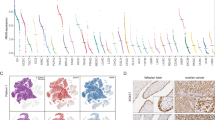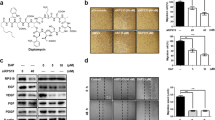Abstract
Paclitaxel (Taxol) is an antineoplastic agent that specifically targets microtubules and arrests cells at the G2/M phase of the cell cycle. In addition to mitotic arrest, the activation of c-Jun N-terminal kinase (JNK) signaling pathway has been demonstrated to be involved in the process leading to apoptosis. In an attempt to explore what genes are transcriptionally regulated by the activated JNK signaling pathway upon paclitaxel treatment, we used cDNA microarrays to analyse the changes of gene expression in human ovarian cancer cells that were treated with paclitaxel and/or the JNK inhibitor SP600125. Among 20 genes that were specifically regulated by the paclitaxel-activated JNK pathway, interleukin (IL)-6 was shown to elicit function through the JAK–STAT signaling pathway in an autocrine and/or paracrine fashion. Subsequently, we identified that 87.5% of eight tested ovarian cancer lines secreted detectable levels of IL-6, which could be further upregulated 2–3.2 fold by 1 μ M paclitaxel. Dissection on regulatory pathways for IL-6 indicated that (i) when ovarian cancer cells were treated with paclitaxel at low but clinically achievable concentrations (exemplified by 1 μ M in this study), the JNK signaling pathway was the major stimulator of IL-6 gene regulation and (ii) at suprapharmacologically high concentrations (exemplified by 50 μ M), paclitaxel exerted lipopolysaccharide-like effects, most likely through the Toll-like receptor 4 signaling pathway. Collectively, these results suggest that paclitaxel upregulates functional IL-6 expression in human ovarian cancer cells through multiple signaling pathways.
This is a preview of subscription content, access via your institution
Access options
Subscribe to this journal
Receive 50 print issues and online access
$259.00 per year
only $5.18 per issue
Buy this article
- Purchase on Springer Link
- Instant access to full article PDF
Prices may be subject to local taxes which are calculated during checkout







Similar content being viewed by others
References
Akira S, Isshiki H, Sugita T, Tanabe O, Kinoshita S, Nishio Y et al. (1990). EMBO J 9: 1897–1906.
Baffet G, Braciak TA, Fletcher RG, Gauldie J, Fey GH, Northemann W . (1991). Mol Biol Med 8: 141–156.
Bain J, McLauchlan H, Elliott M, Cohen P . (2003). Biochem J 371: 199–204.
Bennett BL, Sasaki DT, Murray BW, O’Leary EC, Sakata ST, Xu W et al. (2001). Proc Natl Acad Sci USA 98: 13681–13686.
Blagosklonny MV, Fojo T . (1999). Int J Cancer 83: 151–156.
Brichory FM, Misek DE, Yim AM, Krause MC, Giordano TJ, Beer DG et al. (2001). Proc Natl Acad Sci USA 98: 9824–9829.
Churchill GA . (2002). Nat Genet 32: 490–495.
Cui X, Churchill GA . (2003). Genome Biol 4: 210.
Das KC, White CW . (1997). J Biol Chem 272: 14914–14920.
Dey S, Spring PM, Arnold S, Valentino J, Chendil D, Regine WF et al. (2003). Clin Cancer Res 9: 1557–1565.
Ding AH, Porteu F, Sanchez E, Nathan CF . (1990). Science 248: 370–372.
Dong QG, Sclabas GM, Fujioka S, Schmidt C, Peng B, Wu T et al. (2002). Oncogene 21: 6510–6519.
Du L, Lyle CS, Obey TB, Gaarde WA, Muir JA, Bennett BL et al. (2004). J Biol Chem 279: 11957–11966.
Duan Z, Feller AJ, Penson RT, Chabner BA, Seiden MV . (1999). Clin Cancer Res 5: 3445–3453.
Fang X, Yu S, Bast RC, Liu S, Xu HJ, Hu SX et al. (2004). J Biol Chem 279: 9653–9661.
Flynn Jr V, Ramanitharan A, Moparty K, Davis R, Sikka S, Agrawal KC et al. (2003). Int J Oncol 23: 317–323.
Gorgoni B, Caivano M, Arizmendi C, Poli V . (2001). J Biol Chem 276: 40769–40777.
Hefler LA, Grimm C, Ackermann S, Malur S, Radjabi-Rahat AR, Leodolter S et al. (2003). Cancer Res 63: 3066–3068.
Huang Y, Fan W . (2002). Mol Pharmacol 61: 105–113.
Jordan MA, Wilson L . (2004). Nat Rev Cancer 4: 253–265.
Kawasaki K, Akashi S, Shimazu R, Yoshida T, Miyake K, Nishijima M . (2000). J Biol Chem 275: 2251–2254.
Kawasaki K, Nogawa H, Nishijima M . (2003). J Immunol 170: 413–420.
Kwok BH, Koh B, Ndubuisi MI, Elofsson M, Crews CM . (2001). Chem Biol 8: 759–766.
Lanni JS, Lowe SW, Licitra EJ, Liu JO, Jacks T . (1997). Proc Natl Acad Sci USA 94: 9679–9683.
Lee LF, Haskill JS, Mukaida N, Matsushima K, Ting JP . (1997). Mol Cell Biol 17: 5097–5105.
Lee LF, Li G, Templeton DJ, Ting JP . (1998). J Biol Chem 273: 28253–28260.
Lee LF, Schuerer-Maly CC, Lofquist AK, van Haaften-Day C, Ting JP, White CM et al. (1996). Cancer Res 56: 1303–1308.
Lee YS, Chen CH, Chao A, Chen ES, Wei ML, Chen LK et al. (2005). BMC Genomics 6: 1–10.
Li BY, Mohanraj D, Olson MC, Moradi M, Twiggs L, Carson LF et al. (1992). Cancer Res 52: 2248–2252.
Lin MT, Chang CC, Chen ST, Chang HL, Su JL, Chau YP et al. (2004). J Biol Chem 279: 24015–24023.
Liu J, Yang G, Thompson-Lanza JA, Glassman A, Hayes K, Patterson A et al. (2004). Cancer Res 64: 1655–1663.
Liu ZG, Hsu H, Goeddel DV, Karin M . (1996). Cell 87: 565–576.
Livak KJ, Schmittgen TD . (2001). Methods 25: 402–408.
MacKeigan JP, Collins TS, Ting JP . (2000). J Biol Chem 275: 38953–38956.
Meikrantz W, Schlegel R . (1996). J Biol Chem 271: 10205–10209.
Mingo-Sion AM, Marietta PM, Koller E, Wolf DM, Van Den Berg CL . (2004). Oncogene 23: 596–604.
Nakshatri H, Rice SE, Bhat-Nakshatri P . (2004). Oncogene 23: 7330–7344.
Penson RT, Kronish K, Duan Z, Feller AJ, Stark P, Cook SE et al. (2000). Int J Gynecol Cancer 10: 33–41.
Perera PY, Mayadas TN, Takeuchi O, Akira S, Zaks-Zilberman M, Goyert SM et al. (2001). J Immunol 166: 574–581.
Pusztai L, Mendoza TR, Reuben JM, Martinez MM, Willey JS, Lara J et al. (2004). Cytokine 25: 94–102.
Rosette C, Karin M . (1995). J Cell Biol 128: 1111–1119.
Sriuranpong V, Park JI, Amornphimoltham P, Patel V, Nelkin BD, Gutkind JS . (2003). Cancer Res 63: 2948–2956.
Takeda K, Kaisho T, Akira S . (2003). Annu Rev Immunol 21: 335–376.
Tanaka T, Akira S, Yoshida K, Umemoto M, Yoneda Y, Shirafuji N et al. (1995). Cell 80: 353–361.
Taxman DJ, MacKeigan JP, Clements C, Bergstralh DT, Ting JP . (2003). Cancer Res 63: 5095–5104.
Uematsu S, Matsumoto M, Takeda K, Akira S . (2002). J Immunol 168: 5811–5816.
Uzzo RG, Leavis P, Hatch W, Gabai VL, Dulin N, Zvartau N et al. (2002). Clin Cancer Res 8: 3579–3583.
Villunger A, Egle A, Kos M, Hittmair A, Maly K, Greil R . (1996). Int J Cancer 65: 498–505.
Vivat-Hannah V, You D, Rizzo C, Daris JP, Lapointe P, Zusi FC et al. (2001). Cancer Res 61: 8703–8711.
Wang TH, Lee YS, Chen ES, Kung WH, Chen LK, Hsueh DW et al. (2004). Chang Gung Med J 27: 243–260.
Wang TH, Popp DM, Wang HS, Saitoh M, Mural JG, Henley DC et al. (1999). J Biol Chem 274: 8208–8216.
Wang TH, Wang HS, Ichijo H, Giannakakou P, Foster JS, Fojo T et al. (1998). J Biol Chem 273: 4928–4936.
Wang TH, Wang HS, Soong YK . (2000). Cancer 88: 2619–2628.
Watson JM, Sensintaffar JL, Berek JS, Martinez-Maza O . (1990). Cancer Res 50: 6959–6965.
Wei LH, Kuo ML, Chen CA, Chou CH, Lai KB, Lee CN et al. (2003). Oncogene 22: 1517–1527.
Yusuf RZ, Duan Z, Lamendola DE, Penson RT, Seiden MV . (2003). Curr Cancer Drug Targets 3: 1–19.
Acknowledgements
We thank Dr Chi-Neu Tsai (Chang Gung University) for helpful comments, Ching-Ling Wang and Shih-Yee Mimi Wang (University of Illinois) for technical assistance and Yinin Hu (Northwestern University) for editing help. This study was supported by CMRP890 and NSC92-2314-B-182A-054 (to TH Wang), CMRPG1012 (to TC Chang) and CMRP32049 and NSC92-2314-B-182-083 (to HS Wang).
Author information
Authors and Affiliations
Corresponding author
Rights and permissions
About this article
Cite this article
Wang, TH., Chan, YH., Chen, CW. et al. Paclitaxel (Taxol) upregulates expression of functional interleukin-6 in human ovarian cancer cells through multiple signaling pathways. Oncogene 25, 4857–4866 (2006). https://doi.org/10.1038/sj.onc.1209498
Received:
Revised:
Accepted:
Published:
Issue Date:
DOI: https://doi.org/10.1038/sj.onc.1209498
Keywords
This article is cited by
-
Recent advances in carbohydrate-based paclitaxel delivery systems
Polymer Bulletin (2024)
-
RCC2 over-expression in tumor cells alters apoptosis and drug sensitivity by regulating Rac1 activation
BMC Cancer (2018)
-
Oxidative metabolism drives inflammation-induced platinum resistance in human ovarian cancer
Cell Death & Differentiation (2016)
-
Serum IL-6 level as a predictor of response to neo-Adjuvant chemotherapy in patients of breast carcinoma
Hellenic Journal of Surgery (2016)
-
Using activation status of signaling pathways as mechanism-based biomarkers to predict drug sensitivity
Scientific Reports (2015)



